
Agamidae is a family of over 300 species of iguanian lizards indigenous to Africa, Asia, Australia, and a few in Southern Europe. Many species are commonly called dragons or dragon lizards.
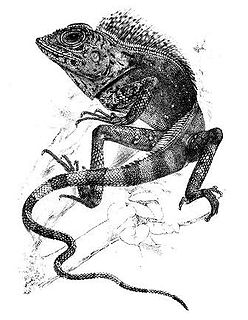
Gonocephalus is a genus of agamid lizards endemic to southeast Asia.

Harpesaurus is a genus of lizards in the family Agamidae. The genus is endemic to Indonesia.

Hypsilurus is a genus of arboreal lizards in the family Agamidae. The genus is endemic to Melanesia.
Japalura andersoniana, Anderson's mountain lizard, is a species of lizard in the family Agamidae. The species is native to southern Asia.
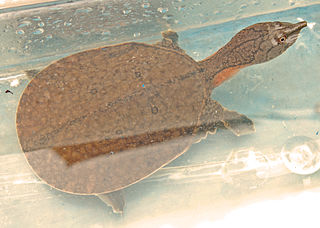
The Malayan softshell turtle is a species of softshell turtle in the family Trionychidae. It is monotypic in its genus.

Abbott's crested lizard, also known commonly as Abbott's anglehead lizard and Cochran's forest dragon, is a species of lizard in the family Agamidae. The species is native to Malaysia and Thailand.

The twin-barred tree snake is a species of snake found in Southeast Asia. It is also called the banded flying snake. It can glide, as with all species of its genus Chrysopelea, by stretching the body into a flattened strip using its ribs. It is mostly found in moist forests and can cover a horizontal distance of about 100 metres in a glide from the top of a tree. It is an oviparous snake.
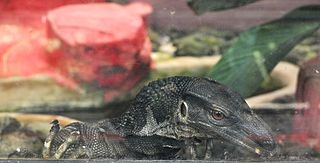
The black roughneck monitor is a species of monitor lizard found in Southeast Asian countries of Thailand, Burma, and Malaysia. It is also found in Indonesia on Sumatra and islands of the Riau Archipelago It is sometimes known simply as the roughneck monitor. In Thailand is called h̄èā cĥāng.

Weber's sailfin lizard, is a species of lizard in the family Agamidae. The species is endemic to Indonesia.

Emoia atrocostata, commonly known as the littoral whiptail-skink, mangrove skink, or littoral skink, is a species of lizard in the family Scincidae. It inhabits mangroves, back-beach vegetation and rocky shorelines. It is semi-aquatic and forages in tidal pools.
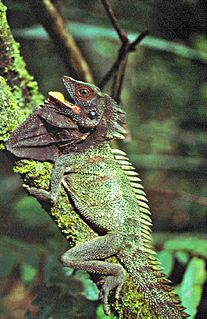
Lophosaurus dilophus, the crowned forest dragon or Indonesian forest dragon, is a large arboreal agamid lizard found in New Guinea and the Moluccan islands, Indonesia.
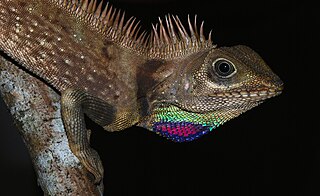
Gonocephalus bellii, commonly known as Bell's anglehead lizard or Bell's forest dragon, is a species of lizard in the family Agamidae. The species is native to Southeast Asia and Oceania.

Lophosaurus is a genus of arboreal agamid lizards from Australia and Melanesia.
Hikida's bow-fingered gecko, also known commonly as Matsui's bent-toed gecko, is a species of lizard in the family Gekkonidae. The species is endemic to the island of Borneo.
Gehyra fehlmanni, also known commonly as Fehlmann's dtella or Fehlmann's four-clawed gecko, is a species of lizard in the family Gekkonidae. The species is native to Southeast Asia.
Malayodracon is a genus of lizard within the family Agamidae. The genus is monotypic, containing the sole species Malayodracon robinsonii. The species, also known commonly as Robinson's anglehead lizard and Robinson's forest dragon, is endemic to Southeast Asia. No subspecies are recognized as being valid.

The Phuwua rock agama is a species of lizard within the family Agamidae. Mantheyus phuwuanensis is the only species in the genus Mantheyus. The species is endemic to Southeast Asia
Gonocephalus beyschlagi, also known commonly as the Sumatra forest dragon, is a species of lizard in the family Agamidae. The species is native to northern Sumatra, Indonesia.
Harpesaurus beccarii, also known commonly as the Sumatra nose-horned lizard or the Sumatran nose-horned lizard, is a species of lizard in the family Agamidae. The species is endemic to Sumatra, Indonesia.














